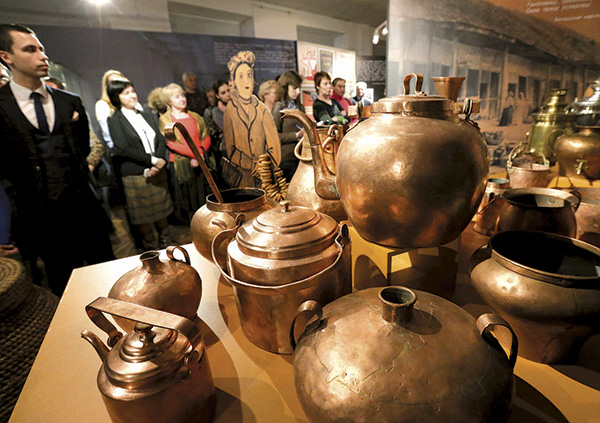Trade of Belarus in the Scales of History exhibition at National History Museum of Belarus
The National History Museum never fails to surprise us, having recently opened a sandy play area and creative studios for children. Its contemporary artistic mosaic, Retrospective 1965-2014, is accompanied by sounds of nature and bird song, and the latest project, Belarus Trade in the Scales of History, is now occupying the third floor, detailing trade from ancient times until the late 19th century.

Trade of Belarus in the Scales of History exhibition
Laminated copies of once secret documents about the opening of various trade sites, trade-regulating laws, banknotes and coins, debt securities and vouchers given to moneylenders are available to see, touch and photograph. Near the entrance, visitors are welcomed by the figure of a salesperson from Soviet times, weighing a ‘bag’ of sweets on the scales, alongside figures of an innkeeper, a craftsman, a merchant, a smuggler and a speculator.
The exhibition is also accompanied by the screening of thematic documentaries and episodes from films, describing the history of trade.
“The idea for the Belarus Trade in the Scales of History project originated more than a year ago, when the History of Trade Study Centre at the Menka Retail Technology Institute conducted a scientific conference at the museum,” notes the Director of the National History Museum of Belarus, Oleg Ryzhkov. Speaking at the opening, he commented, “We came to the conclusion that not only experts but ordinary citizens should be aware of the history of trade, since it’s a daily activity.”
The exhibition includes displays on the peculiarities of trade during the Middle Ages, through to the Russian Empire and the Soviet period, as well as during the 1920s, when smuggling was rife.
Almost every Belarusian museum has contributed artefacts, while some come from private collections. The most ancient are coins and 12th-15th century treasures. The famous ‘Vishchinsky treasure’ was unearthed over 35 years ago, during digs near Vishchinsky Castle (located on the bank of the River Dnieper, between the villages of Vishchin and Kisteni, in the Gomel Region’s Rogachev District). Including silver with gilded decoration, the items are thought to have belonged to the wife of the last owner of Vishchinsky Castle. The treasure also contains payment bars, which are now on show at the History Museum.
Other stands showcase scales and cash registers from various times, children’s toys, jewellery, glass, women’s hats, footwear and other items which could be bought at markets and in shops. Particular leather suitcases were made which enabled smuggling in ‘secret compartments’ in the early 20th century — for such goods as salt and soap.
The exhibition is to run for a year, including round table discussions and scientific conferences, and an interactive programme, to encourage children and adults alike. “Recently, a museum of New Year tree decorations opened, enabling visitors to admire beautiful exhibits and, even, make their own. It’s a great way of welcoming the New Year,” adds Mr. Ryzhkov.
In May 2016, within the same programme, a Viking ship is to be placed on show, highlighting the ‘from the Varangians to the Greeks’ route. Some exhibits will then be donated to the Historical Museum in Lithuanian Klaipeda.
By Yekatetina Medvedskaya











